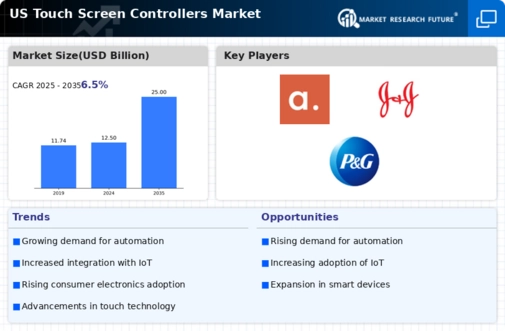Rising Demand for Interactive Displays
The touch screen-controllers market experiences a notable surge in demand for interactive displays across various sectors, including retail, education, and healthcare. As businesses increasingly adopt digital solutions to enhance customer engagement, the need for intuitive interfaces becomes paramount. In 2025, the market for interactive displays is projected to reach approximately $10 billion in the US, indicating a robust growth trajectory. This trend is driven by the desire for more engaging user experiences, which touch screen controllers facilitate effectively. Furthermore, the integration of touch technology in educational tools and healthcare devices underscores the versatility of touch screen controllers, making them indispensable in modern applications. As organizations prioritize user-friendly interfaces, the touch screen-controllers market is likely to expand significantly, reflecting the evolving landscape of consumer expectations.
Increased Adoption in Automotive Sector
The growing reliance on touch screen interfaces in the automotive sector significantly impacts the touch screen-controllers market. As vehicles become more technologically advanced, the integration of touch screens for navigation, entertainment, and vehicle controls is becoming standard. In 2025, it is estimated that the automotive segment will account for approximately 25% of the total touch screen-controllers market in the US. This shift towards digital interfaces aligns with consumer preferences for modern, user-friendly vehicle experiences. Additionally, the push for electric vehicles, which often feature advanced infotainment systems, further propels the demand for touch screen controllers. As automakers prioritize innovative designs, the touch screen-controllers market is poised for substantial growth in this sector.
Expansion of Consumer Electronics Market
The expansion of the consumer electronics market greatly influences the touch screen-controllers market. With the proliferation of smartphones, tablets, and wearable devices, the demand for touch screen technology is at an all-time high. In 2025, the consumer electronics sector is expected to generate revenues exceeding $200 billion in the US, with touch screen devices comprising a substantial portion of this figure. This growth is driven by consumer preferences for intuitive and interactive devices that enhance usability. As manufacturers continue to innovate and improve touch screen technology, the touch screen-controllers market is likely to see sustained growth. The increasing integration of touch screens in everyday consumer products underscores their importance in the modern technological landscape.
Growing Focus on Smart Home Technologies
The increasing emphasis on smart home technologies is a key driver for the touch screen-controllers market. As consumers seek greater control over their home environments, touch screen interfaces are becoming integral to smart home devices. In 2025, the market for smart home technologies is projected to exceed $50 billion in the US, with touch screen controllers playing a vital role in this ecosystem. These interfaces facilitate seamless interaction with various devices, from lighting systems to security cameras. The convenience and accessibility offered by touch screens enhance user experience, making them a preferred choice for smart home applications. As the trend towards home automation continues, the touch screen-controllers market is likely to benefit from this growing demand.
Technological Innovations in Touch Screen Solutions
Technological advancements play a crucial role in shaping the touch screen-controllers market. Innovations such as multi-touch capabilities, haptic feedback, and enhanced durability are transforming user interactions with devices. In 2025, the market is expected to witness a growth rate of around 15% annually, driven by these innovations. Manufacturers are increasingly investing in research and development to create more responsive and reliable touch screen solutions. The introduction of flexible and transparent touch screens further enhances the potential applications of touch technology, from smartphones to automotive displays. As these technologies evolve, they not only improve user experience but also expand the market's reach into new sectors, thereby driving growth in the touch screen-controllers market.













Leave a Comment